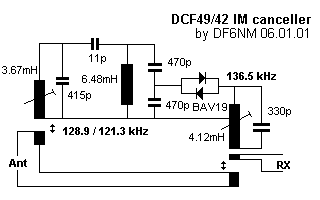Dear group,
last week I have tried to build a novel intermodulation-cancelling circuit,
using a dual-resonant bandfilter for 121.3 and 128.9 kHz, coupled to diodes
to locally generate IM and then add it to the signal in antiphase. Basically,
this scheme acts as a harmonic mixer driven by 2x 128.93 kHz (=DCF49),
linearly converting the DCF42 noise band around 121.3 up to 136.5 kHz. The
gif is a circuit diagram, and I could send pictures and spectra directly.
The first tests showed a significant improvement in the reception of weak
aural CW on 136.5, and in optimal circumstances, the IM-carriers could be
reduced by up to 15 dB. Also the noise floor dropped by up to 5 dB, showing
that some of my background noise on 136 kHz is actually TX-IM of DCF42 data
modulation sidebands. However, I still had no success receiving VE1ZZ yet.
The little circuit is not optimized, and the cancellation is narrowband (200
Hz) and quite sensitive to slight variations in received fieldstrength,
relative phase and antenna tuning.
The concept could probably also be applied to the Rugby problem on 73 kHz. As
the frequencies involved are closer together and fit into an audio band, a
soundcard software implementation might be quite feasible. And how about the
Luxembourg crossmodulation around DBF39 (138.83)? One could think of
subtracting the folded-down upper sideband from the offending lower sideband,
thus converting AM into pure USB...
73 de Markus, DF6NM

|

